《有机化学》课程教学资源(文献)课外中英文对照阅读材料
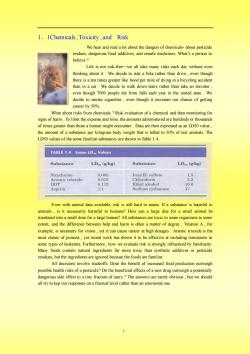
1Chemicals, Toxicity,andRistWe hear and read a lot about the dangers of chemicals-about pesticideresdues, dangerousfood additives, and unsafemedicinsWhat'sa persontbelieveLife is not risk-free-we all take many risks each day without evethinkingride a bikerULthere is a ten times greater like hood per mile of dying in a bicycling accidentthan in a carWe decide to walk down stairs rather than take an elevatoreven though 7000 people die from falls each year in the united state. Wedecide to smoke cigarettes, even though it increases our chance of gettingby.50What abouals?Risk evaluaation ofachemicalandmonitoringfosigns of harmTo limit the expense and time, the amounts administered are hundreds or thousandsoftmesgreaterthanthoseahumanmightencounterDataarethenexpressedasanDaluthe amount of a substance perkilogram body weight that is lethal to50%oftest animals.TheLD50values are shown in Table 1.4ofthesomefamiliarsubstancesTABLE1.4 SomeLDSubstanceLDo (g/kg)SubstanceLDao (g/kg)0.005StrychninIron() sulfate590Dpsenictroxide0.115Sodium eyclamateAspirinIf a substance is harmful toEven with animal data available, riskis still hard to assesharmful tohumans?Hoyanimalm2Alsextent, and the drmisoftedeereexample,isnesaryvinianaueanahghdgsncroxdithmost classic of poisonrecent work has shown it to be effective at including remissions inme types of leukemia.Furthermore,how we evaaluate risk is strongly influenced by familiaritAonscodionoththetic additivespesticidredbecausethe foods are familialns involvetradeoffs.Dose the benefit of increased food production outweiglpossiblehealthrisksofapesticide?Dothebeneficialeffectsofanewdrugoutweighapotentiallydangerous side effectto a tiny fraction of users?The anare rarely obvious, but we shouldall trytokesona fractual level rather than an emtionalo
1 1.1Chemicals , Toxicity , and Risk We hear and read a lot about the dangers of chemicals- about pesticide resdues, dangerous food additives, and unsafe medicines. What’s a person to believe ? Life is not risk-free—we all take many risks each day without even thinking about it . We decide to ride a bike rather than drive , even though there is a ten times greater like hood per mile of dying in a bicycling accident than in a car . We decide to walk down stairs rather than take an elevator , even though 7000 people die from falls each year in the united state . We decide to smoke cigarettes , even though it increases our chance of getting cancer by 50%. What about risks from chemicals ? Risk evaluation of a chemical and then monitoring for signs of harm . To limit the expense and time, the amounts administered are hundreds or thousands of times greater than those a human might encounter . Data are then expressed as an LD50 value , the amount of a substance per kilogram body weight that is lethal to 50% of test animals. The LD50 values of the some familiar substances are shown in Table 1.4 . Even with animal data available, risk is still hard to assess. If a substance is harmful to animals , is it necessarily harmful to humans? How can a large dise for a small animal be translated into a small dose for a large human? All substances are toxic to some organisms to some extent, and the difference between help and harm is often a matter of degree . Vitamin A , for example, is necessary for vision , yet it can cause cancer at high dosages . Arsenic trioxide is the most classic of poisons , yet recent work has shown it to be effective at including remissions in some types of leukemia. Furthermore , how we evaluate risk is strongly influenced by familiarity. Many foods contain natural ingredients far more toxic than synthetic additives or pesticide residues, but the ingredients are ignored because the foods are familiar. All decisions involve tradeoffs. Dose the benefit of increased food production outweigh possible health risks of a pesticide? Do the beneficial effects of a new drug outweigh a potentially dangerous side effect to a tiny fraction of users ? The answers are rarely obvious , but we should all try to kep our responses on a fractual level rather than an emotional one
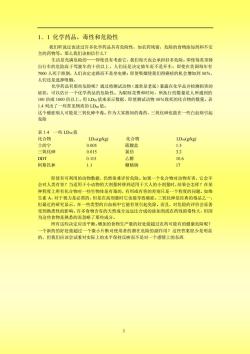
1.1化学药品,毒性和危险性我们听说过也读过许多化学药品具有危险性,如农药残留,危险的食物添加剂和不安全的药物等。那么我们该相信什么?生活是充满危险的一——即使没有考虑它,我们每天也会承担好多危险。即使每英里骑自行车的危险高于驾驶车的十倍以上,人们还是决定骑车而不是开车;即使在美国每年有7000人死于跌倒,人们决定走路而不是坐电梯;即使吸烟使我们得癌症的机会增加到50%,人们还是选择吸烟。化学药品有那些危险呢?通过将测试动物(通常是老鼠)暴露在化学品并检测损害的症状,可以估计一个化学药品的危险性。为限制花费和时间,所执行的数量是人所遇到的100倍或100倍以上。用LD50 值来表示数据,即使测试动物 50%致死的化合物的数量。表4列出了常见物质的LDso值。这个癌症病人可能是三氧化砷中毒。作为大家熟知的毒药,三氧化砷也能在一些白血病引起免除表 1.4一些LDso值LDs0(g/kg)化合物LDs0(g/kg)化合物士的宁硫酸盐0.0051.5氯仿三氧化砷0.0153.2乙醇10.6DDT0.115糖精钠阿斯匹林1.117即使有可利用的动物数据,仍然很难评价危险。如果一个化合物对动物有害,它会不会对人类有害?当适用于小动物的大剂量转移到适用于大人的小剂量时,结果会怎样?在某种程度上所有化合物对一些生物体是有毒的,有用或有害的差别只是一个程度的问题。如维生素A,对于视力是必需的,但是在高剂量时它也能导致癌症。三氧化砷是经典的毒品之但最近的研究显示一些类型的白血病中它能有效引起免除。而且,对危险的评价会显著受到熟悉性的影响。许多食物含有的天然成分远远比合成的添加剂或农药残留毒性大,但因为这些食物是熟悉的而忽略了那些成分所有这些决定应该平衡。增加的食物生产量的好处能超过农药可能有的健康危险呢?一个新药的好处能超过一个微小片断对使用者的潜在危险的副作用?这些答案很少是明显的,但我们应该尝试着对实际上的水平保持反映而不是对一个感情上的东西
2 1.1 化学药品,毒性和危险性 我们听说过也读过许多化学药品具有危险性,如农药残留,危险的食物添加剂和不安 全的药物等。那么我们该相信什么? 生活是充满危险的——即使没有考虑它,我们每天也会承担好多危险。即使每英里骑 自行车的危险高于驾驶车的十倍以上,人们还是决定骑车而不是开车;即使在美国每年有 7000 人死于跌倒,人们决定走路而不是坐电梯;即使吸烟使我们得癌症的机会增加到 50%, 人们还是选择吸烟。 化学药品有那些危险呢?通过将测试动物(通常是老鼠)暴露在化学品并检测损害的 症状,可以估计一个化学药品的危险性。为限制花费和时间,所执行的数量是人所遇到的 100 倍或 1000 倍以上。用 LD50 值来表示数据,即使测试动物 50%致死的化合物的数量。表 1.4 列出了一些常见物质的 LD50 值。 这个癌症病人可能是三氧化砷中毒。作为大家熟知的毒药,三氧化砷也能在一些白血病引起 免除 表 1.4 一些 LD50 值 化合物 LD50(g/kg) 化合物 LD50(g/kg) 士的宁 0.005 硫酸盐 1.5 三氧化砷 0.015 氯仿 3.2 DDT 0.115 乙醇 10.6 阿斯匹林 1.1 糖精钠 17 即使有可利用的动物数据,仍然很难评价危险。如果一个化合物对动物有害,它会不 会对人类有害?当适用于小动物的大剂量转移到适用于大人的小剂量时,结果会怎样?在某 种程度上所有化合物对一些生物体是有毒的,有用或有害的差别只是一个程度的问题。如维 生素 A,对于视力是必需的,但是在高剂量时它也能导致癌症。三氧化砷是经典的毒品之一, 但最近的研究显示,在一些类型的白血病中它能有效引起免除。而且,对危险的评价会显著 受到熟悉性的影响。许多食物含有的天然成分远远比合成的添加剂或农药残留毒性大,但因 为这些食物是熟悉的而忽略了那些成分。 所有这些决定应该平衡。增加的食物生产量的好处能超过农药可能有的健康危险呢? 一个新药的好处能超过一个微小片断对使用者的潜在危险的副作用?这些答案很少是明显 的,但我们应该尝试着对实际上的水平保持反映而不是对一个感情上的东西

2Gasolinoccur naturally in the plant and animal word FoManyalkanexample,thewaxycoating on cabbage leaves contains nonacosane (C29H60),and the wood oil of the Jeffrey pinecommon to the Siera Nevada mountains of California contains heptane(C7H16).By far the majorsources of Alkanes, hoer,are the world's natural gas and petroleum depoederivedfrommatter,primarily of machiefly of methane but also contains ethane, propane, and butanePetroleumacomplemixtureof hydrocarbons that must be separated into fractions and then further refined before itcanbeuseoThe petroleum era began in August1859, when theworld's first oil well was drilled nealTitusville, Pennsylvaniahe petroeum was distiled intoactions accordingtoboilingpoin,buit was high-boiling kerosene, or lamp oil, rather than gasoline that was primarily sougwasbomingwidespreadandoplewantedbtterlightforreadingthanwasavailablomcandlesGasolinewas too volatile forusein lamps and wasinitially considered a wasteby-product. The world has changed greatly since those early days ,however,anditisnowgasoline rather than lamp oil that is prizedacuracsaPetroleunHontingAsphnltModern petroliningbeginsbyfractionaldisillationthree principacutsaccording to theirboiling points(bp):straight-run gasoline (bp30-200 C),kerosene(bp175-300C),and heating oil,or diesel fuel (bp 275-400C).Finally,distllation under reducedeldslubricatig oils and waxes,and leaves an undistillable tarry residue ressureasphafiorne oil is only the firstasolinehproportionofswhichahigroutpoorbecause of engine knock.In the typical four-stroke automobile engine,a piston draws a mixtureoffuel and airinto acylinder on its downward stroke and compressionaspark plug ignites themixture and combustion occugthepiston downward and turningthecrsdrivinglot allfuelsorfuels are used, uncontrolledburn equallywell,thoughrharface in the cylinder beforespark plugfirespreignition,detected as an engine knock,can destroy the engineby putting irregularforces on thcrankshaft and raising engine temperatureThe octane number of a fuel is the measure by which its antiknock properties are judged. Itwas recognized long ago that straight-chain hydrocarbons are far more prone to include engine
3 1.2 Gasoline Many alkanes occur naturally in the plant and animal word .For example , the waxy coating on cabbage leaves contains nonacosane (C29H60), and the wood oil of the Jeffrey pine common to the Sierra Nevada mountains of California contains heptane(C7H16). By far the major sources of Alkanes, however ,are the world’s natural gas and petroleum deposits.are derived from the decomposition of plant and animal matter , primarily of marine origin . Natural gas consists chiefly of methane but also contains ethane , propane, and butane . Petroleum is a complex mixture of hydrocarbons that must be separated into fractions and then further refined before it can be used . The petroleum era began in August 1859, when the world’s first oil well was drilled near Titusville, Pennsylvania . The petroleum was distilled into fractions according to boiling point, but it was high-boiling kerosene, or lamp oil , rather than gasoline that was primarily sought.literacy was becoming widespread , and people wanted better light for reading than was available from candles . Gasoline was too volatile for use in lamps and was initially considered a waste by-product. The world has changed greatly since those early days , however , and it is now gasoline rather than lamp oil that is prized. Modern petroleum refining begins by fractional distillation of crude oil into three principal cuts , according to their boiling points(bp): straight-run gasoline (bp30-200℃), kerosene (bp175-300℃), and heating oil ,or diesel fuel (bp 275-400℃).Finally , distillation under reduced pressure yields lubricating oils and waxes ,and leaves an undistillable tarry residue of asphalt. The distillation of crude oil is only the first step in gasoline production .Straight-run gasoline ,which contains a high proportion of straight chain alkanes , turns out to be a poor fuel because of engine knock . In the typical four-stroke automobile engine , a piston draws a mixture of fuel and air into a cylinder on its downward stroke and compression , a spark plug ignites the mixture and combustion occurs, driving the piston downward and turning the crankshaft. Not all fuels burn equally well , though . when poor fuels are used, uncontrolled combustion can be initiated by a hot surface in the cylinder before the spark plug fires .This preignition , detected as an engine knock , can destroy the engine by putting irregular forces on the crankshaft and raising engine temperature . The octane number of a fuel is the measure by which its antiknock properties are judged. It was recognized long ago that straight –chain hydrocarbons are far more prone to include engine
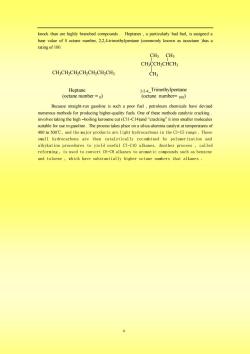
knokthanarehighybranchedmpoudHpanspariularybadaedbase value of 0 octane number,2,2,4-trimethylpentane (commonlyknown as isooctane)hasarating of 100.CH3CH3CH,CCHCHCH;CH;CH,CH,CH,CH2CH,CH3CH32.2.4_TrimethylpentaneHeptane(octane number = o)(octane number=100)Becausesgasoline is suchoorfuel,petroleumchemicals have devisedightnumerous methods for producing higher-quality fuels.One of these methods catalytic crackinginvolves taking the high -boiling kerosene cut (C11-C14)and "cracking" it into smaller moleculessuitable for use in gasoline, The process takes place on a silica-alumina catalyst at temperatures of400 to 500C, and the major products are light hydrocarbons in the C3-C5 range.Thosetalvticalne01is used to convert C6-C8 alkanes to aromatic compounds suchreforminbenzenand toluenewhich have substantially higher octane numbers that alkanes
4 knock than are highly branched compounds . Heptanes , a particularly bad fuel, is assigned a base value of 0 octane number, 2,2,4-trimethylpentane (commonly known as isooctane )has a rating of 100. CH3CH2CH2CH2CH2CH2CH3 Heptane (octane number = 0) CH3CCH2CHCH3 CH3 CH3 CH3 2,2,4_Trimethylpentane (octane number= 100 ) Because straight-run gasoline is such a poor fuel , petroleum chemicals have devised numerous methods for producing higher-quality fuels. One of these methods catalytic cracking . involves taking the high –boiling kerosene cut (C11-C14)and “cracking” it into smaller molecules suitable for use in gasoline . The process takes place on a silica-alumina catalyst at temperatures of 400 to 500℃, and the major products are light hydrocarbons in the C3-C5 range . Those small hydrocarbons are then catalytically recombined by polymerization and alkykation procedures to yield useful C7-C10 alkanes. Another process , called reforming , is used to convert C6-C8 alkanes to aromatic compounds such as benzene and toluene , which have substantially higher octane numbers that alkanes
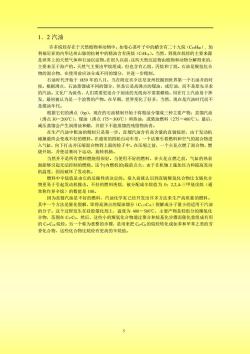
1.2汽油许多烷烃存在于天然植物和动物中。如卷心菜叶子中的蜡含有二十九烷(C2gHao),加利福尼亚的内华达州山脉的松树中的精油含有庚烷(C/H16)。当然,到现在烷烃的主要来源是世界上的天然气体和石油沉淀物。在很久以前,这些天然沉淀物由植物和动物分解得来的,主要来至于海产的。天然气主要由甲烷组成,但也含有乙烷、丙烷和丁烷。石油是羰氢化合在使用前应该分成不同的馏分,并进一步精制。物的混合物,石油时代开始于1859年的八月,当在附近宾夕法尼亚州挖掘到世界第一个石油井的时候。根据沸点,石油蒸馏成不同的馏分,但是它是高沸点的煤油,或灯油,而不是原先寻求的汽油。文化广为流传,人们需要更适合于阅读的光线而不需要蜡烛。用在灯上汽油易于挥发,最初被认为是一个浪费的产物。在早期,世界变化了好多,当然,现在是汽油时代而不是煤油年代根据它们的沸点(bp),现在的石油精制开始于将粗油分馏成三种主要产物:直馏汽油(沸点30-200℃),煤油(沸点175-300℃)和热油,或柴油燃料(275-400℃)。最后,减压蒸馏会产生润滑油和蜡,并留下不能蒸馏的残留物沥青。在生产汽油中粗油的精制只是第一步。直熠汽油含有高含量的直链烷烃,由于发动机碰撞最终会变成不好的燃料,在通常的四轮自动车里,一个活塞引着燃料和空气的混合物进入气缸,向下打击并压缩混合物到上面的轮子中。在压缩之前,一个火花点燃了混合物,燃烧开始,并使活塞向下运动,旋转机轴。当然并不是所有燃料燃烧得很好。当使用不好的燃料,在火花点燃之前,气缸的热表面能够引起无法控制的燃烧。这个(内燃机的)提前点火,由于在机轴上施加压力和提高发动机温度,因而破坏了发动机。由它的反撞性质决定的。很久前就认识到直链羰氢化合物比支链化合科中文心#情物更易于引起发动机撞击。不好的燃料庚烷,被分配成辛烷值为0224-三甲基戊烷(通常称作异辛烷)的数值是100因为直链汽油是不好的燃料,汽油化学家已经开发出许多方法来生产高质量的燃料。其中一个方法是催化裂解,即将高沸点的煤油馏分(Cil-Ci4)裂解成分子量小的适用于汽油的分子。这个过程发生在硅胶催化剂上,温度为400一500℃,主要产物是轻组分的羰氢化合物,范围在C-Cs。然后,这些小的羰氢化合物通过聚合和烷基化步骤而催化重组成有用的C-Cio烷烃。另一个称为重整的步骤,是用来把C-Ca的烷烃转化成如苯和甲苯之类的芳香化合物,这些化合物比烷烃有更高的辛烷值
5 1.2 汽油 许多烷烃存在于天然植物和动物中。如卷心菜叶子中的蜡含有二十九烷(C29H60), 加 利福尼亚的内华达州山脉的松树中的精油含有庚烷(C7H16)。当然,到现在烷烃的主要来源 是世界上的天然气体和石油沉淀物。在很久以前,这些天然沉淀物由植物和动物分解得来的, 主要来至于海产的。天然气主要由甲烷组成,但也含有乙烷、丙烷和丁烷。石油是羰氢化合 物的混合物,在使用前应该分成不同的馏分,并进一步精制。 石油时代开始于 1859 年的八月,当在附近宾夕法尼亚州挖掘到世界第一个石油井的时 候。根据沸点,石油蒸馏成不同的馏分,但是它是高沸点的煤油,或灯油,而不是原先寻求 的汽油。文化广为流传,人们需要更适合于阅读的光线而不需要蜡烛。用在灯上汽油易于挥 发,最初被认为是一个浪费的产物。在早期,世界变化了好多,当然,现在是汽油时代而不 是煤油年代。 根据它们的沸点(bp),现在的石油精制开始于将粗油分馏成三种主要产物:直馏汽油 (沸点 30-200℃),煤油(沸点 175-300℃)和热油,或柴油燃料(275-400℃)。最后, 减压蒸馏会产生润滑油和蜡,并留下不能蒸馏的残留物沥青。 在生产汽油中粗油的精制只是第一步。直熘汽油含有高含量的直链烷烃,由于发动机 碰撞最终会变成不好的燃料。在通常的四轮自动车里,一个活塞引着燃料和空气的混合物进 入气缸,向下打击并压缩混合物到上面的轮子中。在压缩之前,一个火花点燃了混合物,燃 烧开始,并使活塞向下运动,旋转机轴。 当然并不是所有燃料燃烧得很好。当使用不好的燃料,在火花点燃之前,气缸的热表 面能够引起无法控制的燃烧。这个(内燃机的)提前点火,由于在机轴上施加压力和提高发动 机温度,因而破坏了发动机。 燃料中辛烷值是由它的反撞性质决定的。很久前就认识到直链羰氢化合物比支链化合 物更易于引起发动机撞击。不好的燃料庚烷,被分配成辛烷值为 0;2,2,4-三甲基戊烷(通 常称作异辛烷)的数值是 100。 因为直链汽油是不好的燃料,汽油化学家已经开发出许多方法来生产高质量的燃料。 其中一个方法是催化裂解,即将高沸点的煤油馏分(C11-C14)裂解成分子量小的适用于汽油 的分子。这个过程发生在硅胶催化剂上,温度为 400-500℃,主要产物是轻组分的羰氢化 合物,范围在 C3-C5。然后,这些小的羰氢化合物通过聚合和烷基化步骤而催化重组成有用 的 C7-C10 烷烃。另一个称为重整的步骤,是用来把 C6-C8 的烷烃转化成如苯和甲苯之类的芳 香化合物,这些化合物比烷烃有更高的辛烷值
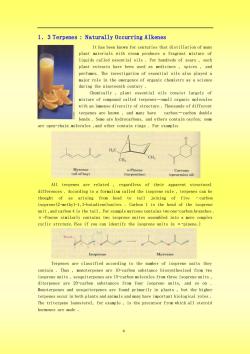
3Terpenes:Naturally Occurring Alkerthasor centuries that distillation of manyL.knownplant materials with steam produces a fragrant mixture ofliquids called essential oilsFor hundreds of yearssuchused as medicplant extractsshauananicesanigatimajor role in the emergence of organic chemistry as a scienceduring the nineteenth centuryChemically,plant essential oils consist largely ofmixtureof corlledterpenessmarganic moleculesnnoundesture.Thousafdifferentdiversity of strcarbon-carbon doubleterpenes areknown,and many haveoondsare hydrocarbons, and others contain oxyfen; somsome open-chainmolecules ,and other contain ringsormple(oilofbay(turpentinepearmint dicturterpenescan beHifferences.a formalism cald the isoprerrule.arbonthoughtrisintailoining3-buteneunieheacoprepcyclicstrcture.y the isoprene units ipinene.)Tvouerpenes are classifaccordinsunitstheontairterneare 10-carbon substance biosynthesed from tsoprunits1car15-narthreaSunitterpelothplantsandanimalsandmanyhaveimporfanthlologlcaroletriterpene lanosterol,orexamples theprecursorfrom whichall sterohormones are made
6 1.3 Terpenes : Naturally Occurring Alkenes It has been known for centuries that distillation of many plant materials with steam produces a fragrant mixture of liquids called essential oils . For hundreds of years , such plant extracts have been used as medicines , spices , and perfumes. The investigation of essential oils also played a major role in the emergence of organic chemistry as a science during the nineteenth century . Chemically , plant essential oils consist largely of mixture of compound called terpenes—small organic molecules with an immense diversity of structure . Thousands of different terpenes are known , and many have carbon—carbon double bonds . Some are hydrocarbons, and others contain oxyfen; some are open-chain molecules ,and other contain rings . For example: All terpenes are related , regardless of their apparent structural differences . According to a formalism called the isoprene rule , terpenes can be thought of as arising from head to tail joining of five –carbon isoprene(2-methyl-1,3-butadiene)unites . Carbon 1 is the head of the isoprene unit ,and carbon 4 is the tail . For example myrcene contains two one-carbon branches . α-Pinene similarly contains two isoprene unites assembled into a more complex cyclic strcture.(See if you can identify the isoprene units in α-pinene.) Terpenes are classified according to the number of isoprene units they contain . Thus , monoterpenes are 10-carbon substance biosynthesized from two isoprene units , sesquiterpenes are 15-carbon molecules from three isoprene units , diterpenes are 20-carbon substances from four isoprene units, and so on . Monoterpenes and sesquiterpenes are found primarily in plants , but the higher terpenes occur in both plants and animals and many have important biological roles . The triterpene lanosterol, for example , is the precursor from which all steroid hormones are made
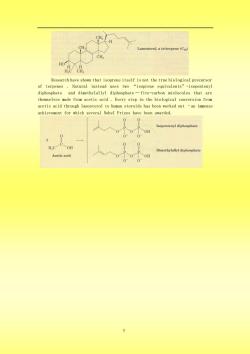
Research have shown that isoprene itself is not the true biological precursorof terpenes.Naturainstead usesisoprene equivalentisopentenyldiphosphateand dimethylallyl diphosphate-five-carbon miolecules that arethemselves made from acetic acid.Every step in the biological conversion fromterol to human steroids has been worked outacetic acidthrouganimmenseeveral Nobel Prizes have been awardedachjevemenfor.whichpentenyl diphosphateCHOmethylallyl diphosphateAcetic acid
7 Research have shown that isoprene itself is not the true biological precursor of terpenes . Natural instead uses two “isoprene equivalents”-isopentenyl diphosphate and dimethylallyl diphosphate — five-carbon miolecules that are themselves made from acetic acid . Every step in the biological conversion from acetic acid through lanosterol to human steroids has been worked out –an immense achievement for which several Nobel Prizes have been awarded
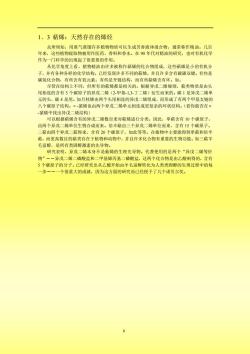
1.3烯:天然存在的烯烃众所周知,用蒸气蒸馏许多植物物质可以生成芳香液体混合物,通常称作精油。几百年来,这些植物提取物被用作医药、香料和香水。在90年代对精油的研究,也对有机化学作为一门科学的出现起了很重要的作用。从化学角度上看,植物精油由许多被称作菇烯的化合物组成,这些烯是小的有机分子,并有各种各样的化学结构。已经发现许多不同的烯,并且许多含有碳碳双键。有些是碳氢化合物,有些含有氧元素:有些是开链结构,而有些粘烯含有环。如:尽管在结构上不同,但所有的烯都是相关的。根据异戊二烯规则,类物质是由头尾相连的含有5个碳原子的异戊二烯(2-甲基-1,3-丁二烯)衍生而来的。碳1是异戊二烯单元的头,碳4是尾。如月桂烯由两个头尾相连的异戊一烯组成,而形成了有两个甲基支链的八个碳原子结构。α-烯也由两个异戊二烯单元相连成更复杂的环状结构。(看你能否在α-烯中找出异戊二烯结构)可以根据烯含有的异戊二烯数目来对烯进行分类。因此,单含有10个碳原子,由两个异戊二烯单位生物合成而来。倍半由三个异戊二烯单位而来,含有15个碳原子。二由四个异戊二菇得来,含有20个碳原子,如此等等。在植物中主要能得到单和倍半,而更高数目的类存在于植物和动物中,并且许多化合物有重要的生物功能。如三羊毛笛醇,是所有类固醇激素的先导物。研究表明,异戊二烯本身不是烯的生理先导物。代替使用的是两个“异戊二烯等价物一异戊二烯二磷酸盐和二甲基烯丙基二磷酸盐,这两个化合物是由乙酸制得的,含有5个碳原子的分子。已经研究出从乙酸开始由羊毛留醇转化为人类类固醇的生理过程中的每一个很重大的成就,因为这方面的研究而已经授予了几个诺贝尔奖北
8 1.3 萜烯:天然存在的烯烃 众所周知,用蒸气蒸馏许多植物物质可以生成芳香液体混合物,通常称作精油。几百 年来,这些植物提取物被用作医药、香料和香水。在 90 年代对精油的研究,也对有机化学 作为一门科学的出现起了很重要的作用。 从化学角度上看,植物精油由许多被称作萜烯的化合物组成,这些萜烯是小的有机分 子,并有各种各样的化学结构。已经发现许多不同的萜烯,并且许多含有碳碳双键。有些是 碳氢化合物,有些含有氧元素;有些是开链结构,而有些萜烯含有环。如: 尽管在结构上不同,但所有的萜烯都是相关的。根据异戊二烯规则,萜类物质是由头 尾相连的含有 5 个碳原子的异戊二烯(2-甲基-1,3-丁二烯)衍生而来的。碳 1 是异戊二烯单 元的头,碳 4 是尾。如月桂烯由两个头尾相连的异戊二烯组成,而形成了有两个甲基支链的 八个碳原子结构。α-蒎烯也由两个异戊二烯单元相连成更复杂的环状结构。(看你能否在α -蒎烯中找出异戊二烯结构) 可以根据萜烯含有的异戊二烯数目来对萜烯进行分类。因此,单萜含有 10 个碳原子, 由两个异戊二烯单位生物合成而来。倍半萜由三个异戊二烯单位而来,含有 15 个碳原子。 二萜由四个异戊二萜得来,含有 20 个碳原子,如此等等。在植物中主要能得到单萜和倍半 萜,而更高数目的萜类存在于植物和动物中,并且许多化合物有重要的生物功能。如三萜羊 毛甾醇,是所有类固醇激素的先导物。 研究表明,异戊二烯本身不是萜烯的生理先导物。代替使用的是两个“异戊二烯等价 物”――异戊二烯二磷酸盐和二甲基烯丙基二磷酸盐,这两个化合物是由乙酸制得的,含有 5 个碳原子的分子。已经研究出从乙酸开始由羊毛甾醇转化为人类类固醇的生理过程中的每 一步――一个很重大的成就,因为这方面的研究而已经授予了几个诺贝尔奖
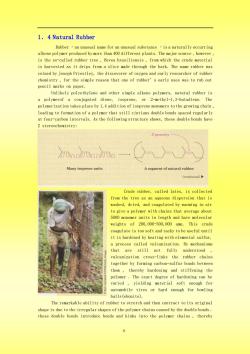
4 Natural RubbelRubber-an unusual namusualsubstanceanaturallyoccurringalkenepolymerproducedbymorethan4oodifferentplants.Themajor source,howeveris the so-called rubber tree,Hevea brasiliensis, from which the crude materialis harvested asit drips from a slice made through the bark. The narubber washeand earlyresearcher of rubbechemistryfor the simple reason that one of rubber' s early uses was to rub outpencil marks on paperUnlikely polyethylene and other simple alkene polymers, natural rubber isapolymerofaconjugateddiene,isoprene,or:2-methyl-1,3-butadiene.Thepolymerization takes place by l,4 addition of isoprene monomers to the growing chainleading to forion of a polymer that still cintians double bonds spaced regularlat four-carbon intervals. As the following structure shows, these double bonds haveZstereochemistryMany isopreneunitsAsegment of natural rubbeontinuedCrude rubber, caiscollecteofrom the tree as an aqusionthatiswashed,dried,aand coagulaoywarminginainlymerwith chains thato giveabo5000velghcoagulateioosoftandtaoseful untiit is hardened byheatingwth elemental sulfur,a process called vulcanizationchanismtogether by formibetweethemtherebyhardeninandtiffening thepolymerThe exact degree ofcanbevariedyielding material soft enough formobile tires or hard enoughfowlinballs(ebonite)The remarkable ability of rubber to stretch and then contract to its originalshape is due to the irregular shapes of the polymer chains caused by the double bondsthese double bonds introduce bends and kinks into the polymer chains , thereby
9 1.4 Natural Rubber Rubber –an unusual name for an unusual substance –is a naturally occurring alkene polymer produced by more than 400 different plants. The major source , however , is the so-called rubber tree , Hevea brasiliensis , from which the crude material is harvested as it drips from a slice made through the bark. The name rubber was coined by Joseph Priestley, the discoverer of oxygen and early researcher of rubber chemistry , for the simple reason that one of rubber’s early uses was to rub out pencil marks on paper. Unlikely polyethylene and other simple alkene polymers, natural rubber is a polymerof a conjugated diene, isoprene, or 2-methyl-1,3-butadiene. The polymerization takes place by 1,4 addition of isoprene monomers to the growing chain , leading to formation of a polymer that still cintians double bonds spaced regularly at four-carbon intervals. As the following structure shows, these double bonds have Z stereochemistry: Crude rubber, called latex, is collected from the tree as an aqueous dispersion that is washed, dried, and coagulated by warming in air to give a polymer with chains that average about 5000 monomer units in length and have molecular weights of 200,000-500,000 amu. This crude coagulate is too soft and tacky to be useful until it is hardened by heating with elemental sulfur, a process called vulcanization. By mechanisms that are still not fully understood , vulcanization cross-links the rubber chains together by forming carbon-sulfur bonds between them , thereby hardening and stiffening the polymer . The exact degree of hardening can be varied , yielding material soft enough for automobile tires or hard enough for bowling balls(ebonite). The remarkable ability of rubber to stretch and then contract to its original shape is due to the irregular shapes of the polymer chains caused by the double bonds . these double bonds introduce bends and kinks into the polymer chains , thereby
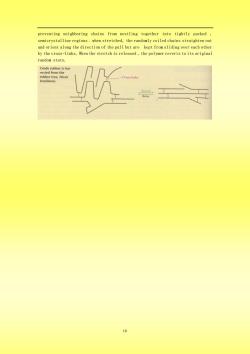
preventing neighboring chains from nestling together into tightly packed,semicrystalline regions.when stretched, the randomly coiled chains straighten outand orient along the direction of the pull but arekept from sliding over each otherby the cross-links. Whenthe stretchisreleased,the polymerreverts toits originalrandom stateCFvestebrasili
10 preventing neighboring chains from nestling together into tightly packed , semicrystalline regions . when stretched, the randomly coiled chains straighten out and orient along the direction of the pull but are kept from sliding over each other by the cross-links. When the stretch is released , the polymer reverts to its original random state
按次数下载不扣除下载券;
注册用户24小时内重复下载只扣除一次;
顺序:VIP每日次数-->可用次数-->下载券;
- 《有机化学》课程授课教案(讲义)第十一章 碳水化合物(糖).doc
- 《有机化学》课程教学大纲 Organic Chemistry.doc
- 中国农业大学:《有机化学》课程教学课件(PPT讲稿)第十八章 周环反应 Pericyclic Reactions.ppt
- 中国农业大学:《有机化学》课程教学课件(PPT讲稿)第十九章 萜类和甾体化合物 Terpenes and Steroids.ppt
- 中国农业大学:《有机化学》课程教学课件(PPT讲稿)第十七章 氨基酸、多肽和蛋白质 Amino acids, Peptides and Proteins.ppt
- 中国农业大学:《有机化学》课程教学课件(PPT讲稿)第十五章 有机杂环化合物 Heterocyclic Compounds.ppt
- 中国农业大学:《有机化学》课程教学课件(PPT讲稿)第十四章 含硫和含磷有机化合物 Sulfur and phophorus organic compounds.ppt
- 中国农业大学:《有机化学》课程教学课件(PPT讲稿)第十六章 碳水化合物 Carbohydrates.ppt
- 中国农业大学:《有机化学》课程教学课件(PPT讲稿)第十章 醇、酚、醚 Alcohols, Phenols and Ethers.ppt
- 中国农业大学:《有机化学》课程教学课件(PPT讲稿)第十三章 含氮有机化合物 Nitrogen Containing Organic Compounds.ppt
- 中国农业大学:《有机化学》课程教学课件(PPT讲稿)第十二章 羧酸及其衍生物 Carboxylic Acids and Their Derivatives.ppt
- 中国农业大学:《有机化学》课程教学课件(PPT讲稿)第十一章 醛和酮 Aldehydes & Ketones.ppt
- 中国农业大学:《有机化学》课程教学课件(PPT讲稿)第七章 有机波谱分析 Structure Analysis of Organic Compounds by Spectrum.ppt
- 中国农业大学:《有机化学》课程教学课件(PPT讲稿)第五章 脂环烃 Aliphatic Cyclic Hydrocarbons.ppt
- 中国农业大学:《有机化学》课程教学课件(PPT讲稿)第八章 对映异构 Enantiomerism.ppt
- 中国农业大学:《有机化学》课程教学课件(PPT讲稿)第九章 卤代烃 Alkyl Halides.ppt
- 中国农业大学:《有机化学》课程教学课件(PPT讲稿)第二章 烷烃 Alkanes.ppt
- 中国农业大学:《有机化学》课程教学课件(PPT讲稿)第四章 炔烃和二烯烃 Alkynes and Dienes.ppt
- 中国农业大学:《有机化学》课程教学课件(PPT讲稿)第三章 单烯烃 Alkenes.ppt
- 中国农业大学:《有机化学》课程教学课件(PPT讲稿)第一章 绪论 Introduction(主讲:覃兆海).ppt
- 《有机化学》课程授课教案(讲义)第四章 对映与非对映异构-精品.doc
- 《有机化学》课程授课教案(讲义)第八章 醛、酮、醌.doc
- 《有机化学》课程授课教案(讲义)第十章 含氮化合物.doc
- 《有机化学》课程授课教案(讲义)第九章 羧酸、羧酸衍生物、取代酸.doc
- 《有机化学》课程授课教案(讲义)第七章 醇、酚、醚.doc
- 《有机化学》课程授课教案(讲义)第六章 卤代烃.doc
- 《有机化学》课程授课教案(讲义)第五章 对映与非对映异构.doc
- 《有机化学》课程授课教案(讲义)第四章 芳香烃.doc
- 《有机化学》课程授课教案(讲义)第一章 绪论.doc
- 《有机化学》课程授课教案(讲义)第二章 烷烃.doc
- 《有机化学》课程授课教案(讲义)第三章 不饱和烃.doc
- 《普通化学》课程教学大纲 General Chemistry.pdf
- 《物理化学实验》课程教学大纲 Experimental Physical Chemistry.pdf
- 《物理化学实验》课程授课教案(讲义)第一章 绪论.doc
- 《物理化学实验》课程授课教案(讲义)第一章 绪论.doc
- 《物理化学实验》课程授课教案(讲义)第一章 绪论.doc
- 《物理化学实验》课程授课教案(讲义)第一章 绪论.doc
- 《物理化学实验》课程授课教案(讲义)第一章 绪论.doc
- 《物理化学实验》课程授课教案(讲义)第一章 绪论.doc
- 《物理化学实验》课程授课教案(讲义)第一章 绪论.doc
